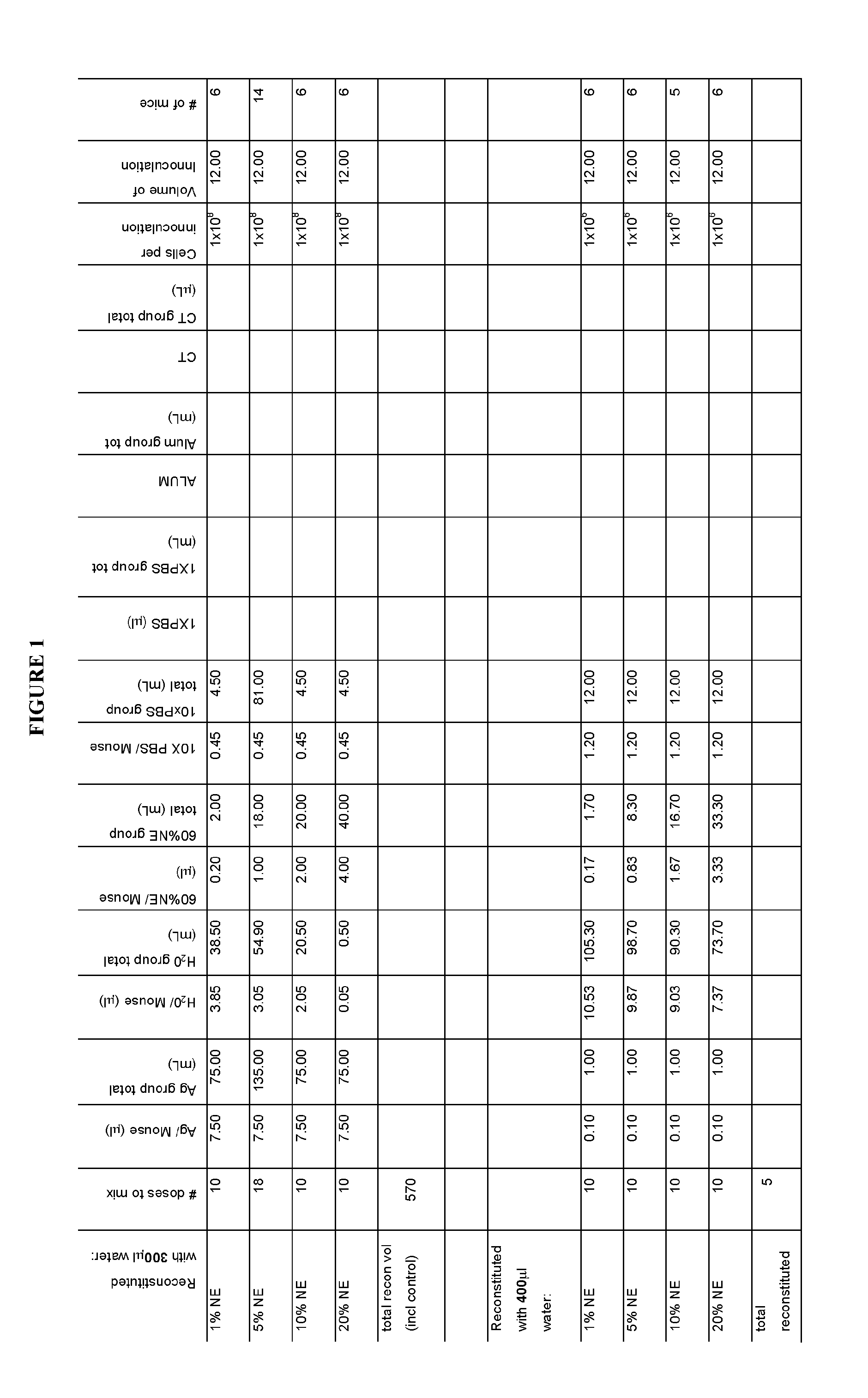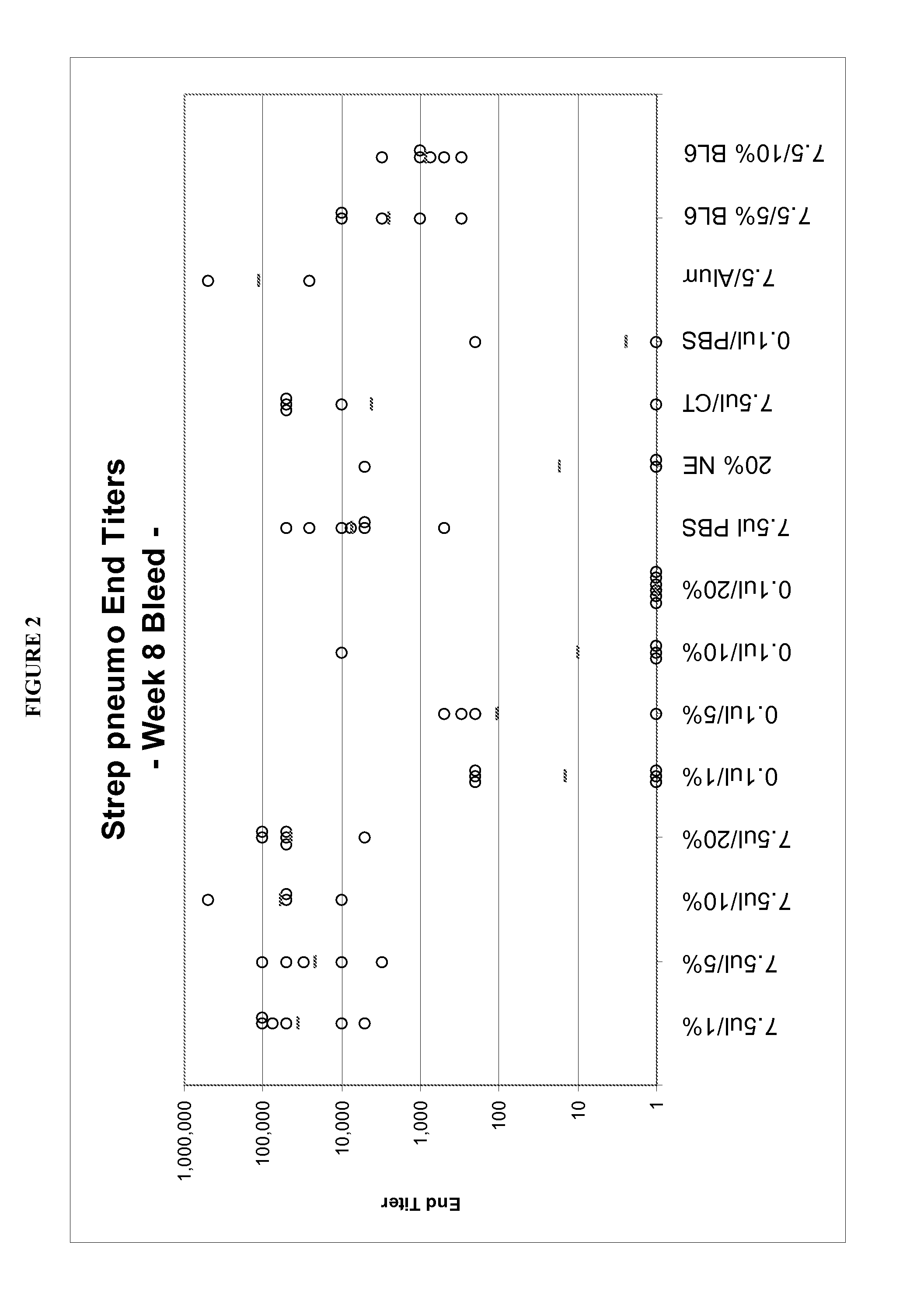Streptococcus vaccine compositions and methods of using the same
a technology of streptococcus and composition, applied in the direction of nanotechnology, antibacterial agents, antibacterial ingredients, etc., can solve the problems of ineffective current vaccine delivery system for a broad spectrum of diseases, inability to repeat immunization, and inability to effectively stimulate immune responses, so as to improve the translation of mrna, enhance the availability or accessibility, and different ligand binding profiles
- Summary
- Abstract
- Description
- Claims
- Application Information
AI Technical Summary
Benefits of technology
Problems solved by technology
Method used
Image
Examples
example 1
Immunogenic Streptococcus pneumoniae Compositions
Experimental Design and Materials and Methods.
[0261]Outbred CD-1 or C57 / B6 (8 groups; 6 mice per group) were intranasally immunized with 7.5 μL or 0.1 μL WCPAg in 1, 5, 10 and 20% NE. WCPAg was generated as follows: strain RX1, a capsule-negative mutant derived from a pneumococcus capsular serotype 2 (e.g., an autolysin (lytA)-negative mutant of RX1 (RX1AL−)) grown at 37° C. in Todd-Hewitt broth supplemented with 0.5% yeast extract (THY) and 0.3 μg of erythromycin / ml to about 109 cells / ml, washed and suspended in saline at 10% of the original volume, and then mixed 3:7 (volume / volume) with ethanol, washed and resuspended in saline, and then frozen for later use.
[0262]The mice were given a volume of 12 μL (6 μL per nare) delivered manually into the nasal cavity of the mouse. Control groups were: 7.5 μL, WCPAg in PBS, cholera toxin (CT), or Alum (delivered intramuscularly); 0.1 μL WCPAg in PBS; 20% NE alone.
[0263]The study design is pre...
example 2
Distribution of Anti-S. pneumoniae Antibody Titers at 8 Weeks after Two Vaccinations
[0277]FIG. 2 shows anti-S. pneumoniae IgG titer distributions at week 8, after two intranasal vaccine doses given one month apart on weeks 0 and 4, for experimental and control groups. All mice vaccinated with 108 CFU WCPAg plus varying concentrations of nanoemulsion obtained a serum antibody titer of 5×103 or greater, with a maximum of 105 and an average across all groups of 7×105. Titers for individual animals (circles) and mean serum titer per group (dash) are shown (See FIG. 2).
example 3
Distribution of Anti-S. pneumoniae Antibody Titers at 10 Weeks after Three Vaccinations
[0278]FIG. 3 shows Anti-S. pneumoniae IgG titer distributions at week 10, after three intranasal vaccine doses given one month apart on weeks 0, 4, and 8 for experimental and control groups. All mice vaccinated with 108 CFU WCPAg plus varying concentrations of nanoemulsion obtained a serum antibody titer of 5×103 or greater, with a maximum of 5×106 and an average across all 108 CFU / vaccine groups of 4×105. Titers for individual animals (circles) and mean serum titer per group (dash) are shown (See FIG. 3).
PUM
| Property | Measurement | Unit |
|---|---|---|
| particle sizes | aaaaa | aaaaa |
| particle sizes | aaaaa | aaaaa |
| particle sizes | aaaaa | aaaaa |
Abstract
Description
Claims
Application Information
 Login to View More
Login to View More - R&D
- Intellectual Property
- Life Sciences
- Materials
- Tech Scout
- Unparalleled Data Quality
- Higher Quality Content
- 60% Fewer Hallucinations
Browse by: Latest US Patents, China's latest patents, Technical Efficacy Thesaurus, Application Domain, Technology Topic, Popular Technical Reports.
© 2025 PatSnap. All rights reserved.Legal|Privacy policy|Modern Slavery Act Transparency Statement|Sitemap|About US| Contact US: help@patsnap.com



